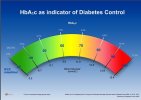This can be a very confusing thing
@michael4479 - especially where BG meters offer their results with seeming decimal point precision!
Legally meters have to have been able to show that they meet ISO accuracy requirements 95% of the time (though 5% of results can be further out). Forum member experience suggests that some make more use of the allowable variation than others.
Forum members have found that the meters which offer a good compromise between affordability and reliability are the
SD Gluco Navii or the
Spirit Tee2 - which both have test strips at around £10 for 50. There are ‘premium brand’ meters which perform very well in bench tests (Accu Chek and Ascensia Next XT often score highly), but their strips can cost 3x as much.
This table (from the Useful Links thread) shows what the allowable variation looks like in practice
BG meter accuracy
It can be quite disconcerting for members new to self monitoring of blood glucose to get different results from BG readings taken close together, even when carefully following manufacturers guidance (washing hands etc). All meters for sale in the UK should comply with the following ISO standards 95% of the time, which allows a degree of variation (and 5% of results can read anything at all). If in any doubt, or if a reading doesn’t match how you are feeling, you should check again with a fresh strip.

